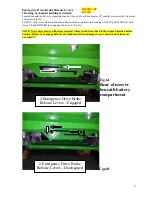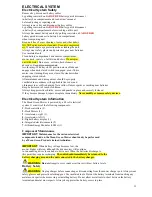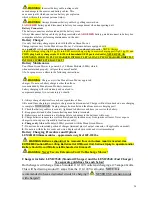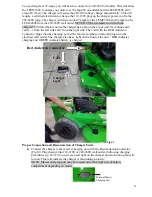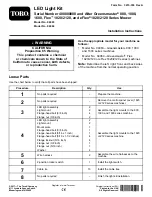
10
Use a walk behind, push mower or hand-held trimmer on
slopes and near drop-offs, retaining walls, drainage
ditches, embankments and water to avoid machine rollover
and serious injury or death.
Do not mow on wet grass. Reduced traction could cause
sliding and loss of steering control.
Do not tow on slopes. The weight of the towed equipment
may cause loss of traction and control.
Do not try to stabilize the machine by putting your foot
on the ground.
If the mower’s tires lose traction when operating on
slopes, disengage the deck blade switch, place the drive control bars
in the neutral position, engage emergency brake, turn the key to the
OFF position and get help.
Never make sudden starts, stops, turns, or reverse direction,
especially when maneuvering on slopes. The steering
is designed for sensitive response. Rapid movement
of the steering control levers in either direction could
result in a reaction of the machine that can cause serious
injury.
Never stop suddenly while backing down slopes. This
action may result in a reaction of the machine that can
cause serious physical injury.
The Mean Green
Mower is capable of operating horizontally
(traverse) on moderate slopes. When operating on slopes
up to 15 degrees, be aware of any conditions that may
cause the mower drive tires to lose traction resulting in a
possible loss of control of the machine. An operator
should not operate on a slope until he is thoroughly
familiar with the equipment.
Do not operate on slopes greater than 15 degrees.
Refer to Slope Guide, page 9A when determining the
degree of slope to be mowed.
It is strongly recommended that the operator drive the
machine off of the slope, using extreme caution, if any
sign of loss of traction is detected. Wait until the condition
that caused the problem is resolved before attempting
to operate on the slope again.
Terrain conditions can affect traction resulting in possible
loss of control of the machine. Some of the conditions
to be aware of are:
1.
Wet terrain
2.
Depressions in the ground; i.e. holes, ruts, washouts
3.
Mounds of dirt
4.
Soil type; i.e. sand, loose dirt, gravel, clay
5.
Grass type, density, and height
6.
Extremely dry conditions of grass
7.
Tire pressure
The attachments mounted to the mower will also
affect the way it handles on a slope. Be aware that each
attachment’s characteristics vary.
Another consideration is to always mow a safe distance
(minimum of 10 feet 3.05 meters) away from drop-offs,
retaining walls, drainage ditches, embankments,
water, and other types of hazards to avoid a wheel dropping
over the edge or to avoid the ground from breaking
away and always be aware of what is located at the bottom
of the slope. This will reduce the risk of the machine
suddenly rolling over causing serious injury or death.
Extreme caution should be used when there is a hazard
located at the bottom of the slope. Some examples
are:
1.
Water; i.e. lake, river

















